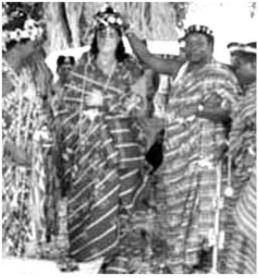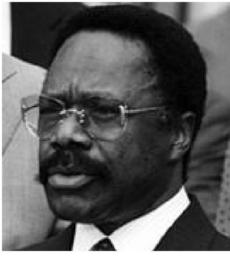Jacko, His Rise and Fall: The Social and Sexual History of Michael Jackson (75 page)
Read Jacko, His Rise and Fall: The Social and Sexual History of Michael Jackson Online
Authors: Darwin Porter

Before arriving in Africa, Michael made certain that his own frozen blood was flown in. Associates reported that he was terrified of contracting AIDS.
He feared that if he became ill during the tour and needed blood transfusions,
he might be injected with tainted blood. "The only blood I trust is my own,"
he told his aides. "See that it's shipped wherever I go."
Like his role model, billionaire Howard Hughes, Michael was almost
paranoicly germ-conscious, once suggesting that he wanted a Plexiglas shield
erected between him and his fans. But he was warned that there would be an
outcry against this. Bob Jones himself felt that such a move would be a public relations disaster. Nonetheless, word of the Plexiglas shield made it into the
press. Eventually Michael abandoned the plan.
Even before his plane touched down in the Republic of Gabon, the local
press was raising provocative questions. One headline read: IS MICHAEL
JACKSON REALLY BLACK? Articles about his changing skin color were
appearing not only in Africa, but in newspapers around the world. Prior to the
example set by Michael, most of the world didn't believe that it was possible
for a black man to change his skin color to white.
Doctors, presumably experts, were interviewed on the subject. From
Europe, Dr. Hans Geiler (country of origin unknown) issued a statement that
a black skin could be turned much lighter by the use of "certain bleaching
agents." A group of compounds known as "Hydroquinones," or so it was
claimed, could make dark skin much lighter-"but not quite white."
Obviously bleaching agents worked better on a light-skinned black or a
mulatto than on persons whose skin was extremely dark or "blue black,"
claimed one doctor, a plastic surgeon, who didn't want to give his name, fearing a "backlash from people of color." As if the world didn't already know
this, the doctor warned, "Race is a delicate issue to discuss."
Thousands of people use Porcelana's Skin Lightening Serum with
Hydroquinone, the only FDA-approved ingredient to effectively lighten skin
discolorations.
Michael was said to travel with tubes of Hydroquinone. In the past it had
been noted that he used Porcelana, a bleaching cream. La Toya was also
rumored to have used Porcelana on her beautiful face.
It was alleged that Michael had studied the makeup techniques of George
Masters, which he perfected with Marilyn Monroe in years immediately prior
to her death. It was called the "white-on-white look." Makeup expert Mitchell
Geller claimed that Masters "transformed Marilyn from Technicolor to 'frosted' way before that became the fashion."
As his skin grew whiter and whiter, Michael developed an aversion to the
sun. The hot sun of Africa held a particular terror for him. "The direct sun
must never touch my face," he warned aides. One way to conceal his face was
to wear large hats. In time, he began to travel with an aide who held a large umbrella, most often black, over his whitening
head.

MJ crowned King of Sani
It was believed that much of Michael's look
came from heavy applications of pancake
makeup. He really coated it on. When any aide
delicately suggested that he might be using too
much, Michael quoted a statement by Masters,
who was acclaimed as the leading makeup
artist of Hollywood. Masters once claimed that
upon Elvis Presley's return from a tour of duty
with the Army in Germany, "he was wearing
more pancake makeup and more mascara than
Marlene Dietrich and Joan Crawford would ever dare."
Attracting thousands of hysterical fans, many of whom were later injured,
Michael touched down in Libreville, the capital of Gabon, a port on the Gabon
River near the Gulf of Guinea. He was there as the guest of Omar Bongo, the
country's president. Although advertised as a good will tour, Michael's trip
was financed by the government ministry, it was later revealed.
Omar Bongo was one of the most controversial of all African leaders, having assumed the presidency of Gabon in 1967 at the age of 32, the world's
youngest president at the time. At the time of his death in 2009, he'd served
as the world's seventh longest serving ruler. If he picked up the tab for
Michael, he could well afford it, as Bongo was one of the globe's wealthiest
heads of state, an empire attributed mainly to oil revenue and alleged corruption.
Bongo emerged in headlines again in 2005, when a Senate investigation
revealed that lobbyist Jack Abramoff had offered Bongo a chance to meet with
President George W. Bush in exchange for $9 million. Ten months later, on
May 26, 2004, Bongo was photographed talking head to head with Bush himself.
In Gabon, grade school children turned out to greet Michael, carrying a
banner that proclaimed: WELCOME HOME MICHAEL. The sounds of
drums filled the air. One nine-year-old boy cried out, "Michael is love, love,
love! I want to be like him."
A British journalist, Peter Hodges, was at the Gabon airport to witness the
arrival of Michael and his entourage. He later wrote provocative copy.
"Michael Jackson often flaunts his arrival at airports with handsome young
boys. Not so in Africa. The word was out that he wanted his companion, Brett
Barnes, to be kept away from the lens of carnivorous paparazzi. Even so, I got
to see the kid get off the plane after the paparazzi went chasing after Michael.
In London, Jackson had passed the boy off as 'Brett Jackson,' his cousin. I
later learned that Brett hails from Sydney, Australia. He was one charismatic and gorgeous boy, fit competition for Tadzio." The journalist was referring, of
course, to the young boy beauty in the Thomas Mann novel, Death in Venice.
In Gabon, President Bongo presented Michael with the Medal of Honor,
an award often reserved for visiting Heads of State such as Nelson Mandela.
Before the good will tour of Africa was over, Michael would visit not only
Gabon, but the Ivory Coast, Tanzania, and Egypt, discovering "Michaelmania" wherever he landed. He logged 30,000 miles in 11 days. His 26-person entourage was flown on a Boeing 707 executive plane. It came complete
with a stateroom, a private bathroom, an open bar, lounges and dining areas,
and lots and lots of video and audio equipment.
One picture of Michael, with his arms outstretched, his hat removed, was
published around the world. Said to be "deeply moved," he was photographed
in front of the world's largest church, the Basilica of Our Lady of Peace, in
Yamoussoakra, capital of the Ivory Coast.
The highlight of the African safari for Michael came in the Cote d'Ivoire,
a little country that had declared itself independent of French colonial rule
back in 1960. Even so, by as late as 1969, the Sanwis of Krinjabo wanted to
break away and form an independent kingdom. Michael was taken to the Ivory
Coast village of Krinj abo, not far from the border with Ghana. The Sanwis had
invited Michael for a coronation ceremony to crown him King.
A little boy born into near poverty in Indiana was welcomed to Africa like
a ruling dignitary and long-lost son. But it wasn't long before sentiment began
to shift against him.
Attired in black trousers and a "flaming" orange shirt, Michael was
fanned by four teenage, bare-breasted girls during his coronation. "Kings" and
chiefs from nearby villages came to town to watch Michael's crowning.
Medicine men chanted incantations as they poured precious gin on the dry
parched earth in honor of the memory of their Krinjabo ancestors.
The traditional tribal chief of Krinjabo, Amon N'Djafolk, placed a crown
of gold on Michael's head and pronounced him "King of Sani." In a whispery
voice, Michael said, "Merci beaucoup. Thank you very much."
He was draped in a traditional gold and orange robe. When he was
crowned, he accepted a long golden chain, a symbol of authority. Placed on a
golden throne and decked out in tribal drag, Michael, in the words of one
reporter, "looked more like a Queen than a King."
Regrettably, Michael insulted the villagers by removing his royal robe
immediately after the ceremony. In the local newspaper, a reporter wrote that
"Michael Jackson's communication talents are lacking." It was later noted that
this was "only one of a series of gaffes and other troubles that caused Michael
to abandon his African trip after a week. Originally he had wanted to visit the
continent to film scenes for a "Return to Africa" video.
Not all was a disaster. During his visit,
Michael went to schools, churches, and institutions for mentally retarded children. In his childlike way he bonded successfully with these children born into a world that was radically different
from the glitzy life that Michael knew in
America.

Omar Bongo
Without his surgical mask, he hugged and
kissed children, some of whom had AIDS. The
tour organizer, Charles Bobbit, said, "I was
impressed with the interaction between Michael
and the children. He sat on the bed with children
who were deformed and children who were ill. He sat there and talked to
them, hugged them, cuddled them."
His feelings were expressed in the song, "Why You Wanna Trip on Me,"
part of the Dangerous album.
Throughout the tour, Michael kept touching his nose. Noting this,
Africans were offended. It appeared that Michael was holding his nose to
avoid the raw smells of Africa. He was said to object in particular to hunks of
meat rotting in the sun and attracting flies.
The editor of Gabon's leading newspaper was direct in his attack. He
called Michael "the sacred beast of America. Holding his nose, he reminds us
that we are undeveloped and that our sewer system doesn't equal that of
California. When he comes into contact with us, he reminds us that we don't
have the luxurious marble bathrooms of rich movie stars in Hollywood. As he
passes our markets, he seems horrified at our rotting foodstuff, noting that we
lack refrigeration. What are we to make of this strange creature among us?
He's not a black man. But not quite white either. He's neither man nor woman
but some androgynous thing caught between the sexes. That might be all right
in a frail little boy. In a grown man, such an effeminate character, who speaks
with the voice of a little girl, is frightening. Maybe it is up to the people of Gabon to turn up their noses at Michael Jackson-not the other way around!"
The scalding editorial didn't diminish the crowds who turned out not to greet
Michael, but to worship him.
The ever-sharp publicist, Bob Jones, rushed to Michael's defense. "We
would not be here if we thought your country smelled," Jones announced in
Gabon. "You are our roots. The air here is fresher than anywhere else." The
publicist dismissed the nose touching as "just a nervous tick Michael has."
But there may have been more to the nose touching than Jones had suggested.
Reports began appearing in America and London that Michael's nose was
in danger of collapsing. Before the debut of his Africa tour, he may have
endured a total of six rhinoplasties. The suggestion was that during his sixth
operation, a hole had appeared in his right nostril that had to be "packed" and
stitched. These stitches may have caused the itching and nose scratching he
experienced in Africa. In London a plastic surgeon speculated that Michael
might one day have to wear a plastic nose.
